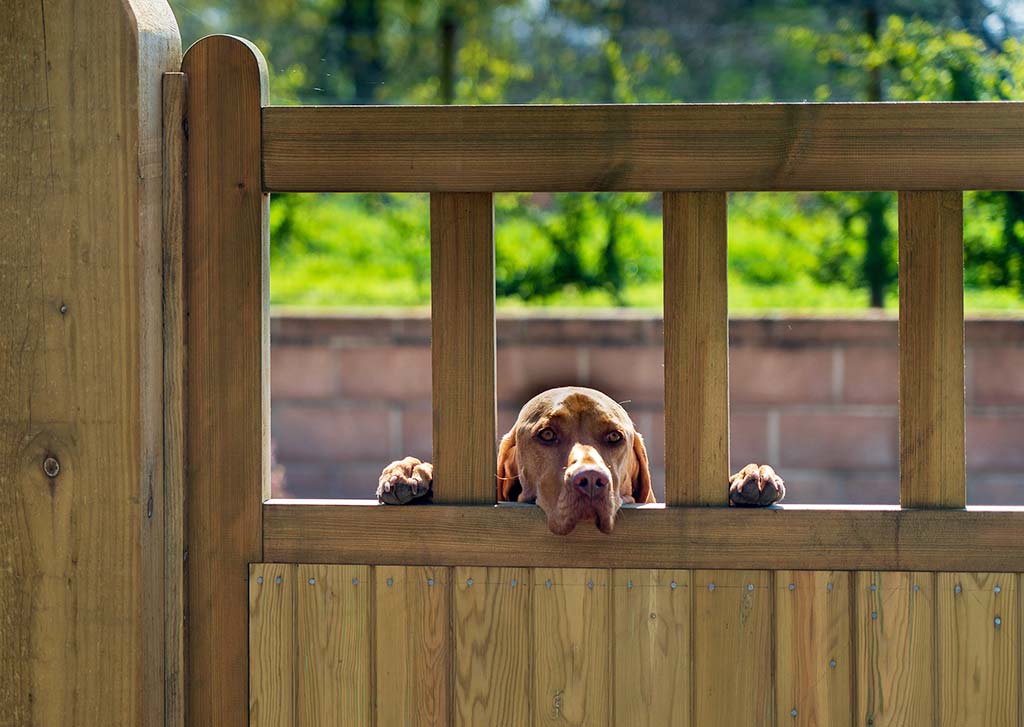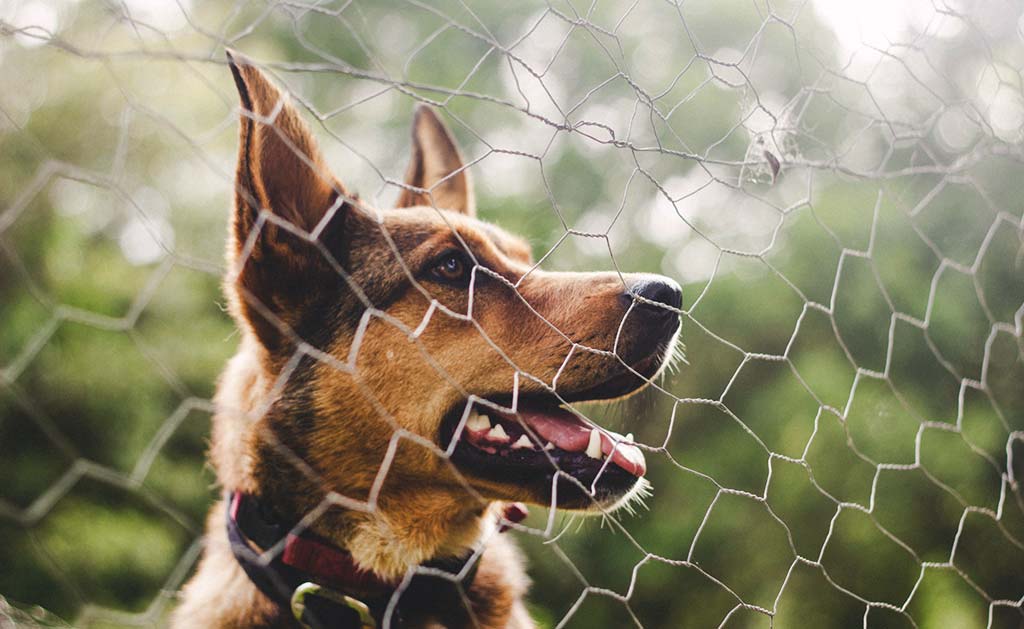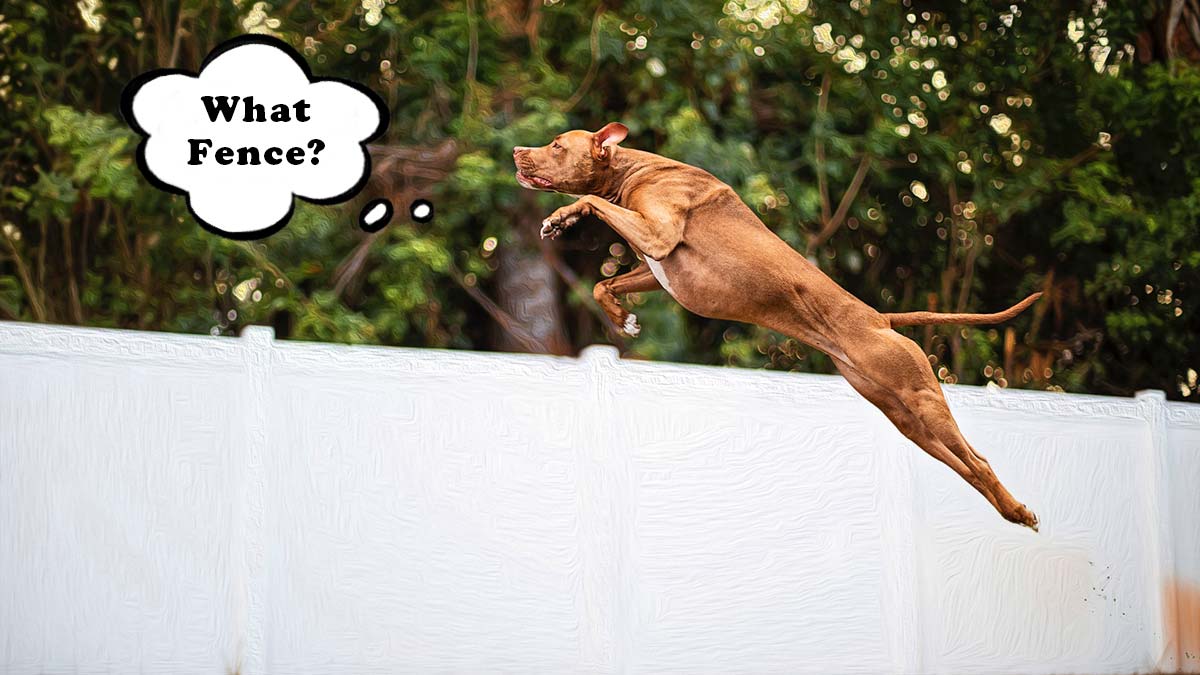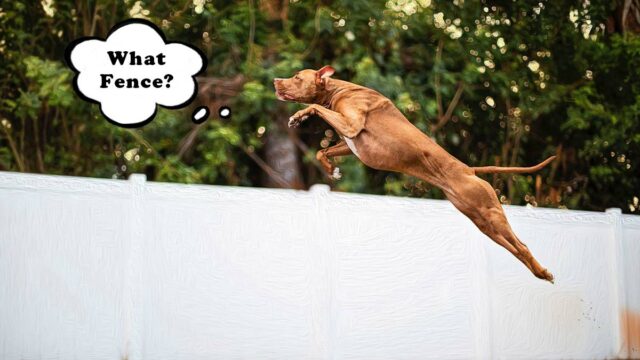Dog Proofing a Fence: Diggity’s Story
Diggity was a mischievous dog who always found a way to dig under the fence in his backyard, no matter how many times his parents tried to stop him. They put up concrete blocks, buried chicken wire underground, and even put up an electric fence, but Diggity always managed to find a way to get out.
One day, Diggity’s parents decided enough was enough and bought him a kite to chase and play with so he had a creative way to burn off his energy. They thought this would be the end of his escape attempts, but Diggity had other plans. He used the kite to fly off OVER the fence — Diggity had done it again.
Okay maybe that got a little far-fetched but it’s frustrating trying to keep our dogs from always escaping from the yard and running into the street or the neighbor’s yard. You’ve tried putting up a fence, but your dog is too smart for that. He or she always finds a way to dig under or jump over it. So how do you dog proof a fence to keep your dog safe and within the confines of your property?

Contents
- Install an Underground Fence
- How To Dog Proof Fence With Chicken Wire
- Install an L-footer at the Base of the Fence
- Add a Top Layer to the Fence
- Add a Second Fence Giving You Two Layers of Protection
- Talk to Your Pet and Make Sure They Follow Your Fence’s Instructions
Many people have challenges keeping their dogs from escaping the yard because they don’t know how to dog-proof a fence properly. Without taking the necessary precautions, dogs are VERY good at finding ways to get out and run free.
This can be dangerous for the dog, as well as for drivers and pedestrians on the street. It’s important to take the time to properly dog-proof your fence so that you and your pet can be safe.
Our neighbor’s dog was particularly good at getting under the chain-link fence. A pit bull mix he was strong enough to just bulldoze right under it no matter what they tried – until they found the perfect solution. In this article, we will outline the best ways to dog-proof your fence so that your dog can stay safe.
Install an Underground Fence
One of the best ways to dog-proof your fence is to install an underground fence a foot or so before the physical fence. This gives you a double layer of protection without having to install two physical fences. This will prevent your dog from digging under the fence and escaping. It’s a great option for busy neighborhoods or yards with multiple dogs, as it will keep all of the dogs contained within the yard.
There are a few different types of underground fences to choose from. One option is a wired fence, which sends a vibration or shock to the dog when he or she crosses the boundary. This type of fence is usually used for larger dogs who are more likely to try and escape. If you have a smaller dog, or if you’re worried about your pet getting shocked, there are also wireless fences available that use a zone control method.
How to install an underground fence
Your first step of course is to map out where you need the fence to go. You’ll need to bury the wire around the perimeter of your yard. Use a shovel to dig a trench where you will bury the wire. The trench should be about 6 inches deep and at least 2 feet wide.
Connect the wire to the transmitter, which you will place in your home. The transmitter will send a signal to the receiver collar that your dog wears. When the dog gets too close to the boundary, he or she will hear a warning beep. If he or she continues to cross the line, they will receive a shock.
While this fence is more expensive than some of the other options, it can be a great way to keep your dog safe and contained. It’s also very easy to use – you just have to make sure the wire is buried correctly so your dog doesn’t get shocked.
What you need to know before installing an underground fence
Call before you dig! The most important thing to do when installing this type of fence is to make sure you don’t hit anything vital when you dig. You don’t want to be the one that gets that kind of shock.
Not all yards are suitable for an underground fence though. Make sure you have enough space for the wire to be buried. The transmitter must be placed in a central location in your yard, and it must be within reach of the wire. You will need to keep the transmitter plugged in at all times for the fence to work.
If your dog is already familiar with the concept of a shock collar, an underground fence might be a good option for you. If your dog is hesitant or fearful of shocks, this might not be the best choice for you.
The benefits of an underground fence
- Keeps your dog safe and contained within the yard
- Easy to use – just bury the wire and plug in the transmitter
- Suitable for all types of dogs big or small
- Works even if your dog is off-leash
How to train your dog to use an underground fence
It’s important to properly train your dog to use an underground fence. If your dog isn’t familiar with the boundaries, he or she might be more likely to try and cross them. Start by slowly introducing your dog to the fence.
Let him or her explore the boundaries and get used to the sound of the warning beep. Once your dog is comfortable with the fence, you can start to increase the distance between the dog and the boundary.
If your dog tries to cross the boundary, don’t punish him or her. This will only make them more hesitant to explore and might cause them to fear the fence. Instead, calmly guide them back to the yard and praise them for staying within the boundary you have set.
How To Dog Proof Fence With Chicken Wire Around the Bottom of the Fence

Placing chicken wire or another obstacle around the bottom of the fence is an effective way to prevent your pet from escaping. This is a simple solution that is easy to do and does not require any extra equipment. Simply place chicken wire or another obstacle around the bottom of the fence to form a barrier that your pet cannot cross.
How to place chicken wire around a fence
- Measure the height and width of the fence.
- Purchase chicken wire that is the same size or larger than your measurements.
- Unroll the chicken wire and cut it to size using scissors or a knife.
- Secure the chicken wire to the fence posts with staples, nails, or zip ties.
What type of chicken wire to use
There are two types of chicken wire: galvanized and PVC. Galvanized chicken wire is stronger and will last longer, but it is also more expensive. PVC chicken wire is less expensive, but it is not as strong as galvanized chicken wire.
Which type of chicken wire you choose to use is up to you. If you have a big dog with some pretty strong chompers galvanized will be your best friend. For smaller dogs, the PVC variety might be just fine.
Benefits of using chicken wire to pet proof a fence
There are several benefits of using chicken wire to pet-proof a fence.
- Chicken wire is an affordable solution that is easy to install.
- It is a deterrent for pets that try to dig under the fence.
- It can also be used to deter pets from climbing or jumping over the fence.
- Chicken wire is a durable material that will last for years.
- It is easy to maintain and does not require any special tools or equipment.
Why shouldn’t I use chicken wire to dog-proof my fence?
One downside of using chicken wire to dogproof your fence is that it might not be as effective at keeping larger dogs in, as they may be able to jump or climb over the fence as well. If you have a large dog, you may want to consider using a different type of deterrent.
Another con is that you might find the addition of chicken wire at the base of your fence is an eye-sore. Depending on the type of fence you have chicken wire might not be the aesthetic you are hoping for.
Install an L-footer at the Base of the Fence

Another way to dog proof your fence is to install an L-footer at the base of the fence. An L-footer is a metal or PVC section of fencing that is installed in the ground and angled upward toward the bottom of the fence. This will prevent your pet from digging under the fence.
When it comes to dog proofing your fence, one of the most effective methods is installing an L-footer. This will prevent your pet from digging under the fence and escaping. This option is somewhat similar to adding chicken wire but an L-footer might be more effective and it has a cleaner appearance.
How to install an L-footer
The installation process for an L-footer is simple, yet a little more advanced than simply running a length of chicken wire around the base. That being said you don’t need expensive tools to do it yourself. Simply:
- Measure the height and width of the fence
- Purchase an L-footer that is the same size or larger than your measurements
- Dig a hole in the ground that is the same size as the L-footer base
- Angle the L-footer upwards and insert it into the hole
- Secure the L-footer to the ground with stakes or concrete
The pros and cons of using an L-footer
On the plus side, an L-footer is a very effective way to keep your pet from digging under the fence. It is an affordable solution that is easy to install. It is durable and will last for years.
The downside of using an L-footer is that it might be difficult to install if you are not comfortable using power tools. You will also need to have a hole dug in the ground before you can install it. Again as with the underground invisible fence – Call before you dig!
Which pets are an L-footer effective for?
An L-footer is a great option for smaller pets that try to dig under the fence. If you have a large dog, they may still be able to dig under the fence, but it will be much more difficult. An L-footer however, is not effective at deterring pets from climbing or jumping over the fence.
Add a Top Layer to the Fence

If digging is not your problem, one of the most effective ways to dog-proof your fence is to add a top layer to the fence. This will prevent your pet from climbing or jumping over the fence. There are several different types of tops that you can choose from, so find one that will work best for your needs. Fence tops include:
Coyote Rollers: If you are looking for a more high-tech solution, you might consider using coyote rollers. Coyote rollers are metal or PVC tubes that spin when a pet tries to climb over the fence. This will cause the pet to lose its balance and fall back down.
Spikes: These are sharp spikes that are installed along the top of the fence. They will deter your pet from trying to climb over the fence. Depending on your fence appearance and your taste for badassery spikes may or may not be the look you are going for.
Electrified Fence Top: This is a fence that has been electrified with a shock to keep your pet from escaping. It is a more extreme option, but it is very effective at keeping pets in.
Pros and Cons of Fence Toppers
There are several pros and cons to adding a fence topper to your fence. The pros of using a fence topper are that it is an effective way to keep your pet from climbing or jumping over the fence. Depending on the material you use it can be a relatively affordable solution. Although the cost can also fall into the con category if you are adding a more elaborate top like spikes, wire, or an electrified topper.
Costs Involved
The cost of adding a fence topper to your fence varies depending on the type of topper that you choose. A cheap wood lattice might only be $15 per eight-foot section. While spikes might start at $40 per section. You will also need to factor in the cost of installation, which can be done by a professional or you can do it yourself.
DIY or Hire a Professional?
If you are comfortable with DIY projects, you can install a fence topper yourself. If you are not comfortable with using power tools or do not have the time, you can hire a professional to do it for you. Professionals typically charge around $75-$100 per hour to install a fence topper.
Add a Second Fence Giving You Two Layers of Protection
Many people underestimate the importance of a second fence. A second fence will provide an extra layer of protection to keep your dog in. Even if your dog gets past the first fence, it may not be able to climb or jump over the second fence because there is no room to get a running start. Adding a second fence is an easy way to dog-proof your property and ensure that your pet stays safe.
What type of fence to use for a second layer
When choosing a fence for your second layer, you need to make sure that it is not something that your pet can easily climb or jump over. The best option is usually a solid fence such as a wooden privacy fence or a chain-link fence. If you live in an area with wildlife, you might also want to consider adding a coyote or deer fence to your property. These fences are designed to keep animals out, and they are very effective at doing so.
Factors to consider when adding a second fence
When adding a second fence to your property, there are several factors that you need to take into consideration. The most important factor is the height of the fence. You want to make sure that the second fence is at least as high as the first fence. If your pet can easily jump over the first fence, it will be able to get out of the property as well.
Another factor to consider is the type of fence that you are using. If you are using a chain-link fence, make sure that the mesh size is small enough so that your pet cannot fit through it. If you are using a wooden privacy fence, make sure that the slats are close together so that your pet cannot climb through them.
The last factor to consider is the location of the fence. You want to make sure that the fence is not too close to the edge of your property. If your pet can jump or climb over the fence, it will be able to get out of the property.
Pros and cons of having a second fence
The pros of using a second fence are that it is an effective way to keep your pet from escaping if one fence just isn’t cutting it. The cons of using a second fence are that it can be time-consuming, difficult to install, it’s double the cost of a single fence, and it might not be necessary if you have a well-made first fence.
Talk to Your Pet and Make Sure They Follow Your Fence’s Instructions
The number one rule for all pet fences is do not cross. No matter what kind of fence you have, it’s important to talk to your pet and make sure they are taking your fence’s needs to heart.
Some fences, like electric fences, don’t like to be touched – they are very clear about that. They very much dislike being peed on.
Other fences like beautiful wooden fences like to be looked at and admired – they probably don’t like the peeing either.
I’m being mostly facetious in this section but teaching your pet how to be friends with your fence is also important. A well-trained dog is a safe and happy dog.
If you have a dog that simply does not like to be contained another option is looking into an escape-proof dog crate specifically designed for escape artists. By keeping them calm and secure in their crate they are less likely to become a fence jumper.
But when all else fails and your dog REALLY likes to make friends with the dog next door, some of these ways to dog proof your fence might come in handy.









